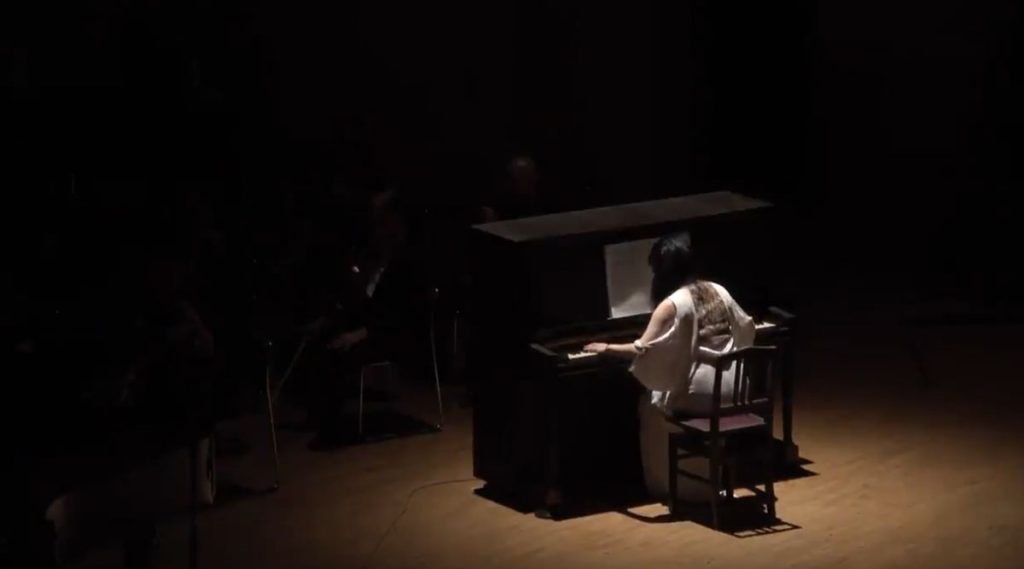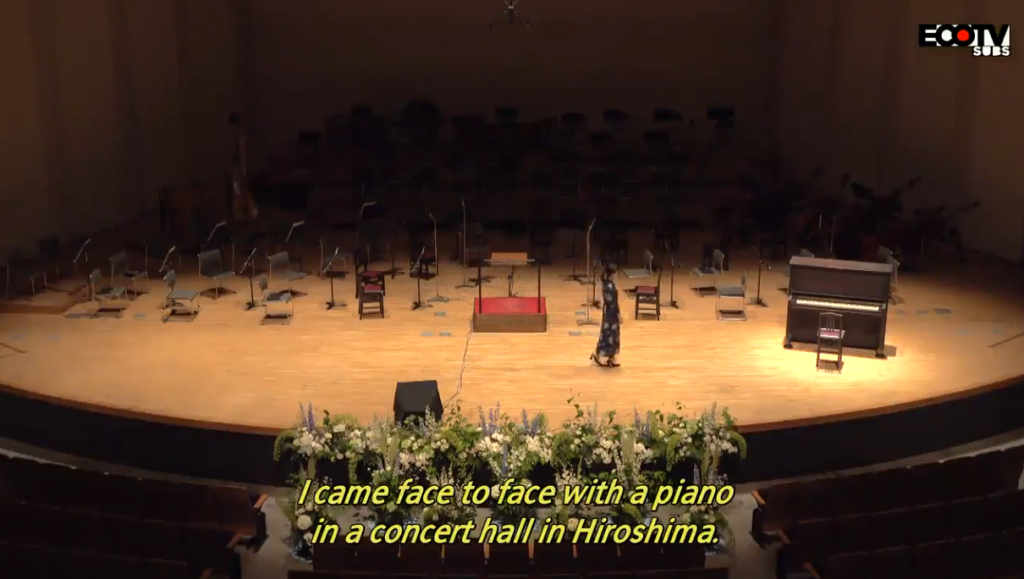Akiko’s Piano: The Memories of a Piano – 80 Years After the Atomic Bomb
Can a piano develop something like a personality and retain memories of the people who have played it? This is one of the questions asked in a play by Heike Tauch and Florian Goldberg in which one of the main characters is a piano that survived the atomic bombing of Hiroshima. Since it was restored in the early 2000s, “Akiko’s piano” has featured in concert performances, films, and special events, conveying its message of peace. Now, 80 years after the bomb killed its owner, it has also participated in the Hiroshima premiere of the play Borrowed Landscape.

The authors first learned about Akiko’s piano from a Japanese journalist based in Berlin. Moved by the instrument’s tragic and unique story, they were soon immersed in the creation of Borrowed Landscape, a play combining narration with music by the Japanese composer Dai Fujikura. The play was first broadcast on German Radio in 2022 and had its stage premiere in New York the following year. On February 16, 2025, the play was performed in Japanese in Hiroshima, with Akiko’s piano on stage.
The Piano’s Story – who was “Akiko”?
Akiko Kawamoto was born in Los Angeles to Japanese parents in 1926. While she was still only a baby, her parents bought an upright Baldwin piano, made in Cincinnati, Ohio. Akiko was six years old when the family moved back to Japan and brought the piano with them to their new home in Hiroshima.
Akiko loved her piano and practised all the way through childhood. At one point, she even had piano lessons every day of the week. In her diary, she often wrote about how much she enjoyed playing. But when she was a teenager, war broke out. She had to visit the Army Hospital as a volunteer, participate in air-raid drills, and help tend fields of vegetables. She could not study the subjects she wanted, and naturally, there was less time to spend at the piano.
The Atomic Bombing
Akiko was 19 and working as a mobilized student when the atomic bomb was dropped on Hiroshima. She was just 800 meters from the epicenter of the blast, but initially survived and was able to find her way home through the rubble. She even had to swim across a river, because the bridge to her home had been destroyed.
The family’s house had collapsed, and the piano had suffered damage to its left side, which faced a window. To this day, it bears fragments of glass that were blown into the wood by the blast. It seemed Akiko had narrowly escaped death, but unfortunately, she was so severely poisoned by radiation that she died the next day. She was cremated and buried under a big persimmon tree in the family’s garden, which is still there today.
60 Years of Silence
Akiko’s parents preserved all her belongings, including her diaries and the damaged piano. However, no one played or even touched the instrument for almost 60 years.
In 2004, the family gave the piano to Ms. Tomie Fukatuchi, who was once a neighbor to the Kawamotos and used to visit them when she was a child. Sometimes, Mrs. Kawamoto would tell her stories about Akiko and the piano. In the hope that children in Hiroshima would convey a message for peace through music, Ms. Fukatuchi had the instrument restored by piano technician Hiroshi Sakaibara, who used as much of the original parts as possible. In August 2005, Akiko’s beloved piano was played for the first time in concert. Since then, it has been used in many recitals to commemorate the bombing of Hiroshima.
Ms. Fukatuchi founded the HOPE Project, which supports peace education through Akiko’s story. The piano is now on permanent display in the Hiroshima City Peace Memorial Park Rest House, and is used for educational purposes and special performances.
Join Piano Street today!
Enjoy reading this article? Get instant unlimited access to aricles, news, sheet music and more in Piano Street’s treasure trove of classical piano music with a membership.
A Piano with a Personality
Many notable pianists have performed on the instrument when visiting the city. Martha Argerich appeared with the Hiroshima Symphony Orchestra for a peace concert in 2015. Two days later, she went to see and play Akiko’s piano. Ms. Argerich said, “I think the piano loves to play Chopin, strangely enough. Apparently, the girl, Akiko, she used to love Chopin and play Chopin. Maybe the piano has the memory of this.”
Martha Argerich – spontaneous performance on Akiko’s piano (2015)
Martha Argerich playing Ravel Jeux d’eaux on Akiko’s piano
In 2017, Peter Serkin played Akiko’s piano and was very moved by its sound. He said, “This piano amazingly has a voice of its own, reminiscent of the tone of some lovely old 18th and 19th century pianos, with its warm and human voice, which wants to sing! Its singing consoles us and can also express a gratitude for life itself.”
For the 75th anniversary of the bombing in 2020, Dai Fujikura composed a piano concerto where the cadenza part is meant to be played on Akiko’s piano.
Composer Dai Fujikura about his Piano Concerto No. 4 “Akiko’s Piano”
daifujikura.com/prog_akikos_piano
The same year the film Akiko’s Piano was released, mixing dramatized episodes from Akiko’s life, documentary material, and footage from the premiere performance of Fujikura’s concerto.
Akiko’s Piano (2020) – full length film mixing drama, documentary and footage from the world premiere of Dai Fujikura’s Piano Concerto No. 4 “Akiko’s Piano”
A Universal Story
In Borrowed Landscape, the story of Akiko’s piano is intertwined with those of a famous Stradivarius, walled up for years in a cellar in Budapest, and a double bass, left behind in 1939 when its owner fled from Poland. Instruments that tell the stories not only of their respective owners, but the story of every life disrupted by the cruelties of war. Heike Tauch, one of the co-authors of the play, who sadly died last summer following a battle with cancer, explained in one of her last interviews why these stories are not just of historic significance: “Akiko’s piano is not a thing of the past. In this very moment, many Akikos are probably dying in Ukraine, Gaza and Israel without the world noticing.”
NHK World Japan about the Japanese stage premiere
Borrowed Landscape, performed in English at the Noguchi Museum New York, 2023
The Piano that Loved Chopin – a short film about Akiko’s piano, made by the Hiroshima City Ushita Middle School Broadcast Club
Join Piano Street today!
Enjoy reading this article? Get instant unlimited access to aricles, news, sheet music and more in Piano Street’s treasure trove of classical piano music with a membership.

Comments